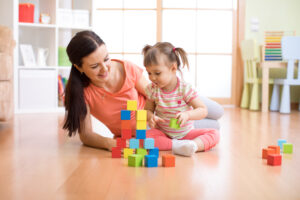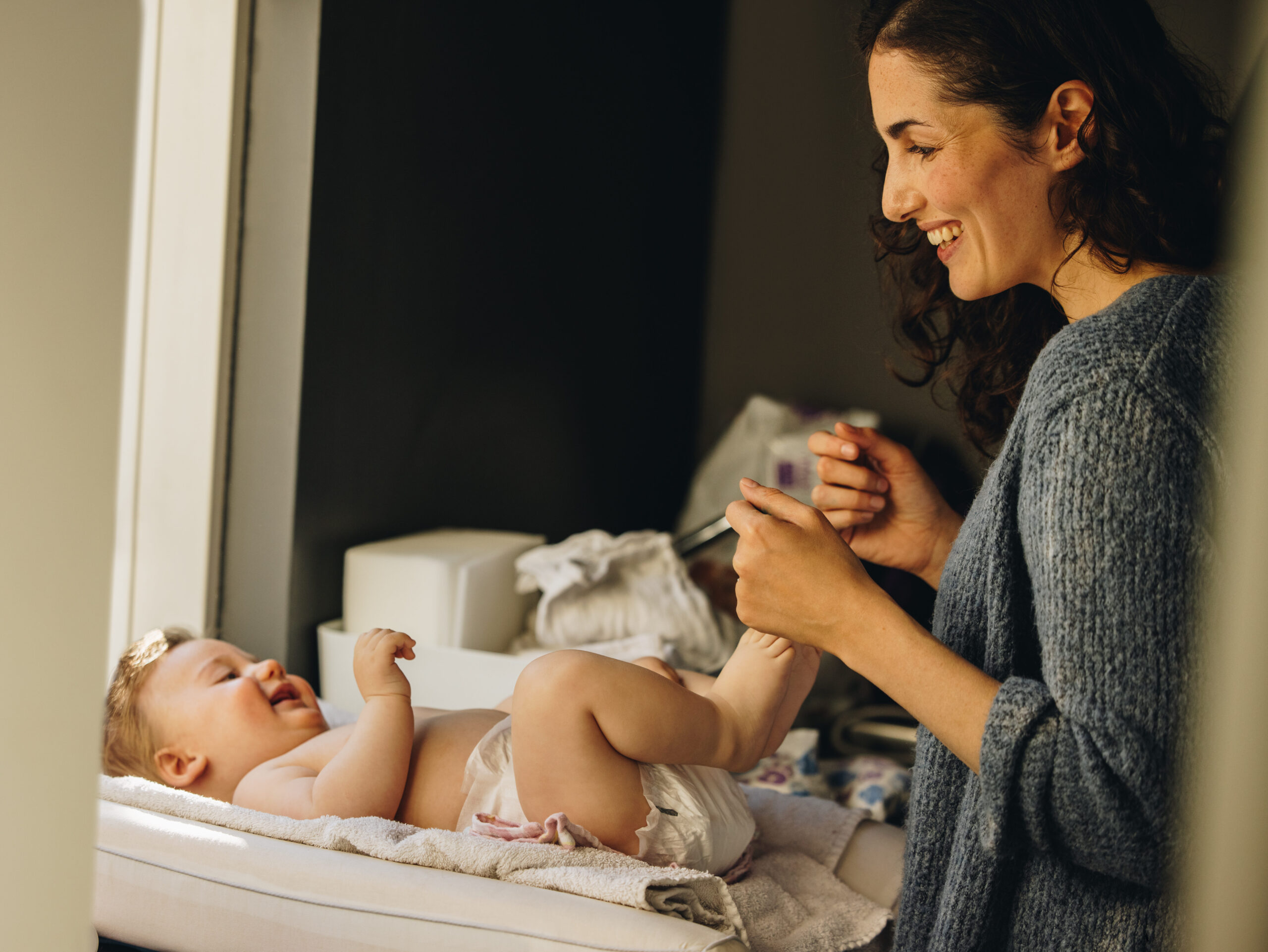
How to Play
As parents, we get so much feedback about what we can do to enhance our baby’s development. Sometimes, it can be difficult to remember one
Just think of how much time babies spend in routines of one kind or another: sleeping, bathing, feeding, and diaper changing, not to mention dressing, getting in or out of a carseat or stroller…and the younger the child, the less time they spend doing much else! These activities require the child’s cooperation, and routines and rituals can help. Routines and rituals can offer an anchor, a predictable sequence of events, and an assurance that the child’s needs will be met. They honor the space (who the child is) and create a place (for example, a fixed bedtime) that matches the rules of your family.
Just because something is a routine doesn’t mean it doesn’t have value for the child’s development. With young children especially, important learning and connection can happen in the course of everyday routines!
Routines offer children:
Research even suggests that when parents learn to implement routines and limits, their children are more likely to develop a healthy body weight!
Through routines, children learn:
We can also build important self-regulation skills and cooperation in our children when we integrate choices into routines. It may not be a choice to bundle up for the cold weather before we head outside, but we can include in the “going out” routine the choice for the child to wear the blue or orange hat, or whether to lie down or stand up for a diaper change (provided that they—and we!—are able, and that the diaper’s not a messy one, of course!).

So what are rituals?
Rituals and routines have a lot in common. Routines are any everyday, predictable activities we do with our child—diapering, dressing, bathing, leaving the house. It can become a ritual when we bring intention, a sense of purpose to the routine that makes it feel like more than just getting the job done. We often think of rituals as religious or cultural practices, but a ritual can be as simple as a morning practice of greeting the day with your child:
When Krystal returned to work, she had to bring 6-month-old Ruby to her childcare very early, and this meant waking Ruby, who was a bit of a night owl (like her mama!). At first it was a struggle to begin the day earlier, so Krystal created a simple wake-up ritual. Each morning Krystal picks Ruby up from the crib and says quietly, “Good morning, sweet Ruby!” and walks her to the window, where they say good morning to the sunshine (sometimes they need to look for it!), good morning to the clouds, good morning to the cars, good morning to the people walking to work,…always ending with “good morning to everything!”
Rituals like Krystal and Ruby’s need not take long, and they can turn a difficult or mundane routine into something special, sidestepping struggle for a shared experience of meaning and connection.
Tips for creating successful routines and rituals:
Yuki has a calm and regular temperament, and it seems like her eyes start to droop at just the sight of her pajamas and a warm bottle. Her parents read the same short book each night, a rhyming story of a baby getting ready for bed. They’ve made up a tune for the last pages, which they repeat as they lift her into her crib, kiss her on the head and turn off the lights as they leave the room. Her brother Toshi is a highly active child, so a longer bedtime ritual is needed to help him wind down for sleep. They are sure to end screen time at least an hour before bedtime and set aside 15 minutes of “special time” when Toshi chooses the activity to play with his parent (always with the limit that it can’t be what they call “rough-house” or active play after dinner). Then it’s bath time, one book of his choosing, followed by the same night-night book his sister reads, the song, kiss and lights out.
These are hard times. Routines and rituals can help.
You may have experienced—and you may be continuing to experience—changes in your family’s routines because of the COVID-19 pandemic. New research on the impact of the pandemic on families shows that you’re not alone. The good news is that researchers have also confirmed that families can adapt better to difficult circumstances by creating and maintaining rituals and routines. Predictable routines and rituals can help ease the stress of daily life in uncertain and stressful times. This is true for children of all ages…and for adults, too!
Remember…
Not every single routine or activity you do with your child needs to become a ritual. It’s okay for some things to just have to get done, and of course not every experience a child has will be repeated regularly. Whether you are engaged in a routine, ritual, or neither, keep in mind we can always aim to bring intention, attunement and communication with our child.

As parents, we get so much feedback about what we can do to enhance our baby’s development. Sometimes, it can be difficult to remember one

Children thrive when they are provided with a predictable, structured environment. Routines provide a sense of safety and security, as well as foster healthy emotional and

Routines are consistent ways to do daily tasks. They provide structure, consistency, and predictability. Routines are welcome comforts in your baby’s ever-changing world. The repetition

As parents, we get so much feedback about what we can do to enhance our baby’s development. Sometimes, it can be difficult to remember one

Children thrive when they are provided with a predictable, structured environment. Routines provide a sense of safety and security, as well as foster healthy emotional and

It’s hard to wait! It can be hard for adults, and it’s even harder for young children. Psychologist Walter Mischel and colleagues have spent decades

An excerpt from a behind-the-scenes interview with Dr. Kathy Hirsh-Pasek at the 2018 Simms/Mann Institute Think Tank

As parents, we get so much feedback about what we can do to enhance our baby’s development. Sometimes, it can be difficult to remember one
| Cookie | Duration | Description |
|---|---|---|
| __stripe_mid | 1 year | Stripe sets this cookie cookie to process payments. |
| __stripe_sid | 30 minutes | Stripe sets this cookie cookie to process payments. |
| cookielawinfo-checkbox-advertisement | 1 year | Set by the GDPR Cookie Consent plugin, this cookie is used to record the user consent for the cookies in the "Advertisement" category . |
| cookielawinfo-checkbox-analytics | 11 months | This cookie is set by GDPR Cookie Consent plugin. The cookie is used to store the user consent for the cookies in the category "Analytics". |
| cookielawinfo-checkbox-functional | 11 months | The cookie is set by GDPR cookie consent to record the user consent for the cookies in the category "Functional". |
| cookielawinfo-checkbox-necessary | 11 months | This cookie is set by GDPR Cookie Consent plugin. The cookies is used to store the user consent for the cookies in the category "Necessary". |
| cookielawinfo-checkbox-others | 11 months | This cookie is set by GDPR Cookie Consent plugin. The cookie is used to store the user consent for the cookies in the category "Other. |
| cookielawinfo-checkbox-performance | 11 months | This cookie is set by GDPR Cookie Consent plugin. The cookie is used to store the user consent for the cookies in the category "Performance". |
| CookieLawInfoConsent | 1 year | Records the default button state of the corresponding category & the status of CCPA. It works only in coordination with the primary cookie. |
| elementor | never | This cookie is used by the website's WordPress theme. It allows the website owner to implement or change the website's content in real-time. |
| viewed_cookie_policy | 11 months | The cookie is set by the GDPR Cookie Consent plugin and is used to store whether or not user has consented to the use of cookies. It does not store any personal data. |
| Cookie | Duration | Description |
|---|---|---|
| mailchimp_landing_site | 1 month | The cookie is set by MailChimp to record which page the user first visited. |
| Cookie | Duration | Description |
|---|---|---|
| _ga | 2 years | The _ga cookie, installed by Google Analytics, calculates visitor, session and campaign data and also keeps track of site usage for the site's analytics report. The cookie stores information anonymously and assigns a randomly generated number to recognize unique visitors. |
| _gat_gtag_UA_46801669_2 | 1 minute | Set by Google to distinguish users. |
| _gid | 1 day | Installed by Google Analytics, _gid cookie stores information on how visitors use a website, while also creating an analytics report of the website's performance. Some of the data that are collected include the number of visitors, their source, and the pages they visit anonymously. |
| tk_lr | 1 year | The tk_lr is a referral cookie set by the JetPack plugin on sites using WooCommerce, which analyzes referrer behaviour for Jetpack. |
| tk_or | 5 years | The tk_or is a referral cookie set by the JetPack plugin on sites using WooCommerce, which analyzes referrer behaviour for Jetpack. |
| tk_r3d | 3 days | JetPack installs this cookie to collect internal metrics for user activity and in turn improve user experience. |
| tk_tc | session | JetPack sets this cookie to record details on how user's use the website. |
| Cookie | Duration | Description |
|---|---|---|
| cookies.js | session | No description available. |
| m | 2 years | No description available. |